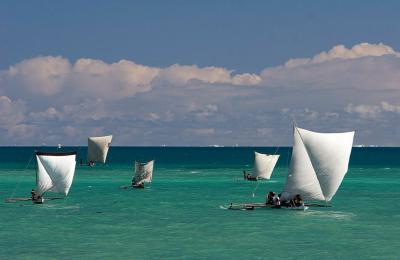Local management is paving the way for marine conservation and recovering coastal fisheries in the Western Indian Ocean
Article by Sr588 [at] york.ac.uk (Steve Rocliffe), University of York and Al [at] blueventures.org (Alasdair Harris), Blue Ventures
When some of the older residents of Andavadoaka village in southwestern Madagascar were children, they were forbidden to swim in the sea at dawn or dusk, for fear of attracting unwelcome attention from the sharks. Here small-scale fishing accounts for 82% of household income but today the sharks have all gone, fished, along with sea cucumbers, for lucrative export markets. Most of the larger fish have also vanished, sold to local markets or consumed by a coastal population that’s doubling in size every 10-15 years.
Rural Malagasy in the South West have also been hit particularly hard by the declines. For the nomadic Vezo communities that inhabit this region, seafood is the sole source of protein in 99% of household meals. And they’re far from alone. At least 97% of the world’s fishers live in developing countries, the vast majority working in small-scale fisheries in the tropics. These fisheries are vital to around 500 million people worldwide, providing a lifeline for families and coastal economies, and underpinning food security for entire nations.

Within the Velondriake LMMA 87% of the adult population are fishers. Traditional sailing pirogues like these are essential for transportation and fishing.
But the Vezo communities are fighting back, village by village, against this ecological and social crisis. With assistance from British NGO Blue Ventures, they set up The Velondriake Community Managed Protected Area. Covering nearly 1,000 km2, it is the one of the largest marine managed areas in Madagascar and the first to be managed at the local level.
Velondriake’s success has triggered a wave of grassroots replication. In 7 years, 34 new Locally Managed Marine Areas (LMMAs) have been created around Madagascar’s shores, covering nearly 7% of the country’s seabed. At over 6,500km2, this is almost 3 times more than in centrally managed marine protected areas.
Yet despite emerging as a tool of choice in parts of the WIO, LMMAs are often hampered by underdeveloped legal structures and enforcement mechanisms. To address these issues, work is underway in both Madagascar and across the region to establish LMMA networks which allow practitioners to share best practice and promote local management to other communities and governments.
Madagascar isn’t the only country in the region where this revolution in marine management is underway. Almost half of the Western Indian Ocean's (WIO) protected areas are under some form of community stewardship. And in Kenya, Mozambique and Tanzania especially, LMMAs are proving themselves to be a cost-effective, scaleable, resilient and more socially acceptable alternative to more traditional ‘top-down’ methods of marine resource management. Taken together, these sites are protecting more than 11,000km2 of marine resources helping local communities to manage and conserve their natural resources and rebuild tropical fisheries.
For more information on LMMAs in the Western Indian Ocean please see
Rocliffe S, Peabody S, Samoilys M, Hawkins JP (2014) Towards A Network of Locally Managed Marine Areas (LMMAs) in the Western Indian Ocean. PLoS ONE 9: e103000. doi:10.1371/journal.pone.0103000.
Harris, A.R., 2011. Out of sight but no longer out of mind: a climate of change for marine conservation in Madagascar. Madagascar Conservation & Development 6.
(Photo Credit: Blue Ventures / Garth Cripps)




